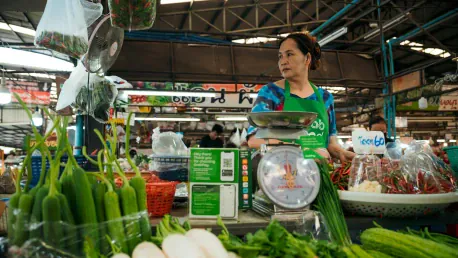Shopping for groceries has come a long way from the days of visiting local market traders and high street greengrocers. Today’s consumers are looking for convenience, personalization, and efficiency. Generative AI (Artificial Intelligence) has the potential to transform grocery shopping by offering intelligent, personalized, and hassle-free experiences. This technological advancement not only elevates the shopping process but also introduces a level of sophistication and user engagement that was previously unattainable with traditional methods.
Generative AI represents a monumental leap from the days when grocery shopping involved selecting produce from a local vendor. It promises a seamless experience where consumers can enjoy tailored recommendations and efficient service. This paradigm shift moves far beyond the capabilities of current systems, making the dream of a truly personalized shopping experience a reality.
Moving Beyond Traditional Chatbots
Most of us have interacted with basic chatbots that can answer limited queries. However, generative AI takes this a notch higher by facilitating real conversational commerce. Unlike logic-based chatbots, generative AI can engage in dynamic, context-aware, and sophisticated dialogues, providing a more interactive and fulfilling user experience.
In traditional settings, chatbots often reach their limitations quickly. For example, a typical chatbot might only understand straightforward questions and provide predetermined responses. Generative AI, on the other hand, leverages large datasets to ensure its responses are more personalized and relevant, making it a far superior tool for customer interaction. This transition fosters a richer, more connected experience for the consumer, radically reshaping how they interact with the grocery sector.
With generative AI, the dialog isn’t just transactional. It can detect the nuances of consumer behavior and preferences over time, adapting to provide more accurate and helpful suggestions. Consumers could feel more understood and catered to, as the AI grows to “learn” about their needs and habits. This transformative capacity ensures that customers are not merely receiving service but are instead engaging in a meaningful and productive dialogue with an intelligent system designed to meet their unique needs.
The Amazon Example: Rufus
Amazon’s launch of Rufus, an expert shopping assistant, serves as a perfect case study for the application of generative AI. Rufus is designed to enhance the shopping experience through vast knowledge of Amazon’s product catalog and other web-based information. By integrating with the customer’s order history, Rufus provides highly personalized shopping advice.
Rufus operates on multiple levels—guiding users at the onset of their shopping journey, providing detailed product information, and managing customer interactions within the Amazon app. This multifaceted approach enriches the user experience, setting a high standard for what is possible with generative AI in grocery retail. It offers a seamless, integrated experience that anticipates customer needs and addresses them in real-time, transforming how consumers shop and interact with the platform.
For grocery retailers, implementing an AI like Rufus can facilitate a seamless and interactive shopping experience, from the very first search to the final purchase. This approach can transcend beyond the mere utility of a shopping assistant to an essential companion in the grocery shopping journey. AI-driven assistants like Rufus demonstrate the profound potential of generative AI, highlighting its capability to transform and elevate the consumer shopping experience.
Interactive Shopping Journeys
Consider a typical search for an item like “bananas” evolving into a more comprehensive inquiry like planning an “Olympics-themed BBQ.” Generative AI can transform simple searches into detailed, contextually rich shopping experiences. It can suggest not only the most appropriate types of bananas but also beverages, snacks, and accessories for the event.
This interactive shopping experience is not limited to listing items. Generative AI can engage customers with helpful commentary, recommending various categories like sausages, buns, and paper plates. The AI’s ability to include contextual insight in its recommendations creates an advisor-like experience that significantly enhances user satisfaction. This means that shopping becomes more than just a transactional experience; it evolves into a personalized journey that feels uniquely tailored to the shopper’s needs and preferences.
Instead of just offering product lists, generative AI ensures that everything one might need for an occasion is thoroughly considered, making the process more efficient and enjoyable. This holistic approach can substantially elevate the perceived value of grocery shopping. By taking into account user preferences and historical behavior, generative AI crafts a shopping experience that feels both intuitive and deeply personalized, ultimately making the process more engaging and satisfying.
Enhanced Product Recommendations
Generative AI can revolutionize product recommendations, making them more personalized and meaningful. Traditional recommendation engines rely on simple algorithms, often failing to account for the complexities of individual preferences. Generative AI, however, analyzes vast amounts of data to provide more accurate and timely suggestions.
For example, if a customer adds lettuce to their basket, the AI might recommend cucumbers and tomatoes next—a logical continuation based on common shopping patterns. Such tailored guidance simplifies decision-making for the shopper, making the experience more instinctive and user-friendly. This ability to predict and suggest enhances the customer’s experience, making them feel understood and valued.
Moreover, generative AI leverages predictive analytics to foresee customer behavior. It can predict when a customer might book their next delivery slot based on past actions or suggest dietary preferences for future orders. These capabilities go beyond simple product recommendation to offer a proactive, intuitive shopping experience. By anticipating needs and preferences, generative AI ensures that customers receive a level of service that feels both responsive and highly personalized.
The Future of Predictive Shopping
Visualize a future where grocery retailers can predict and fulfill orders with minimal active input from customers. While this might appear intrusive initially, it aligns with the natural shopping habits and preferences of customers, enabling an almost hands-free shopping experience. This vision of predictive shopping entails a system so deeply integrated with the customer’s habits and preferences that it can anticipate needs with remarkable accuracy.
Supermarkets already possess extensive data on customer purchase patterns. Incorporating generative AI can allow these retailers to utilize this data more effectively, making intuitive and informed decisions about what customers need and when they need it. This shift not only enhances customer convenience but also optimizes inventory management and reduces waste, benefiting both the retailer and the consumer.
Imagine an intelligent assistant that knows you’ll need extra supplies for a weekend family gathering or understands your dietary preferences. By preemptively filling orders and offering intelligent suggestions, this AI-driven method could revolutionize grocery shopping, making it more convenient and less time-consuming. The key to this future lies in the ability of generative AI to synthesize vast amounts of data and convert it into actionable insights that benefit the consumer.
Broader Implications for the Industry
The integration of advanced AI capabilities into the grocery sector signifies a broad trend towards enhanced customer experience and operational efficiency. Retailers are recognizing the potential advantages of leveraging predictive analytics and conversational AI to meet modern consumer expectations for convenience and personalization. This movement is poised to redefine the industry, offering smarter, more efficient solutions that cater to increasingly sophisticated consumer demands.
Generative AI offers smarter recommendations, accurate predictions of customer behavior, and the ability to streamline complex interactions. As this technology evolves, it can further reduce the cognitive load on customers by automating routine purchase decisions, thereby addressing the significant pain points of busy modern lifestyles. The result is a grocery shopping experience that feels both effortless and highly personalized, engendering greater customer satisfaction and loyalty.
By leveraging the power of generative AI, grocery retailers can create a more responsive and adaptive shopping environment. This not only improves the individual consumer’s experience but also offers broader operational benefits, such as optimized inventory and reduced waste. As AI technology continues to advance, its integration into the grocery sector will likely bring even more profound changes, further enhancing both efficiency and customer satisfaction.









